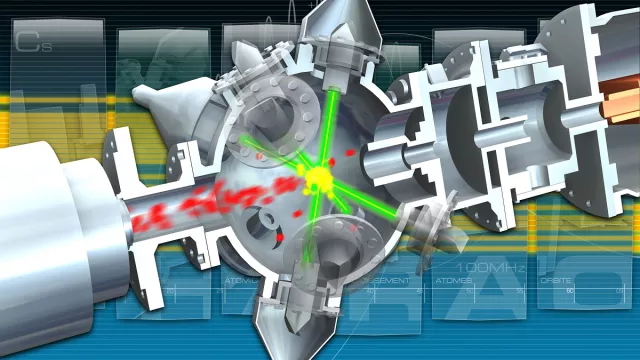Early in 2025, PHARAO will become the first caesium cold-atom clock ever to orbit Earth, operating outside the International Space Station as part of a time-comparison network. Does this mean the station’s crew will be able to keep time more accurately than on Earth?
Key information
| Mission | Measure time with an accuracy of 10-16 and test Albert Einstein’s theory of gravitation more precisely than ever before |
|---|---|
| Domain | Science |
| Launch date | Launch to ISS on 21 April 2025 |
| Partners | ESA and industry, working with French research laboratories (ENS-LKB and OBSPM-SYRTE) |
| Where | International Space Station (ISS), Columbus module |
| Lifetime | 3 years |
| Status | In development |
Key figures
- 40 microseconds/day: time difference between positioning satellites and ground
- 91 kg: mass of PHARAO
- 5 subsystems
- 10-16 precision
Key milestones
- 21 April 2025: Scheduled launch of PHARAO
- July 2014: Delivery of PHARAO flight model to ESA
- March 2014: Start of PHARAO performance tests
- January 2011: Testing of ground segment prototype
- December 2008: CNES approves construction of PHARAO flight model
Project in brief
Albert Einstein’s theory of general relativity predicts that time slows near a source of gravitation. As a result, it passes more quickly at the top than at the foot of the Eiffel Tower. This ‘Einstein effect’—also called gravitational redshift—is even more clearly perceptible in space, which is why satellite positioning systems like GPS or Europe’s Galileo have to factor it in to obtain a precise positional fix. In their 20,000-km orbit, these systems’ atomic clocks gain 40 microseconds every day with respect to Earth-bound clocks. The PHARAO mission is designed to measure this effect with new levels of accuracy.
PHARAO will become the first caesium cold-atom clock ever to orbit Earth and operate as part of a time-comparison network, attached to a porch on the European Columbus module outside the International Space Station (ISS). PHARAO is called a ‘cold-atom’ clock because its caesium atoms are laser-cooled to a temperature approaching absolute zero (–273°C) to render them virtually motionless so that the ‘tick-tock’ oscillations of the wave they emit can be counted more accurately. According to the SI international system of units, a second is defined as the duration of 9,192,631,770 oscillation cycles of a caesium atom.
Cold-atom clocks are currently the best clocks operating on Earth. In the microgravity environment of space (the ISS orbits Earth at an altitude of 400 kilometres), they will be even more accurate. For example, PHARAO is expected to lose no more than one second every 300 million years. Such extreme accuracy will enable the effects predicted by the theory of general relativity to be verified more precisely than ever before.
CNES’s role
The PHARAO mission’s clock draws extensively on research conducted at French laboratories. Its constituent elements were built by French manufacturers and then assembled and tested by CNES. PHARAO is the core component of the European ACES mission (Atomic Clock Ensemble in Space).
Contacts
Project Leader
Didier Massonnet
E-mail: didier.massonnet at cnes.fr
Fundamental Physics subject matter expert
Martin Boutelier
E-mail: martin.boutelier at cnes.fr


